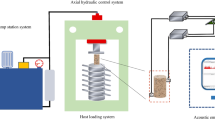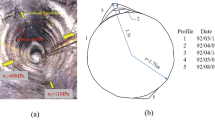Abstract
A series of clay shale specimens in equilibrium with various humidity conditions were used to establish the water retention characteristics, the influence of suction on ultrasonic p-wave velocity and rock mechanical properties such as Young’s modulus, Poisson’s ratio, onset of dilatancy, unconfined compressive strength and Brazilian tensile strength. Opalinus Clay, a clay shale considered as host rock for the disposal of nuclear waste in Switzerland was utilized. The results showed that the p-wave velocity normal to bedding (v p,n) dropped sharply upon desaturation until suction approached the air-entry value. The sharp decrease was associated with desiccation cracks solely oriented parallel to bedding. For suction in excess of the air-entry value, v p,n was constant, indicating no further desiccation damage. The suction at the shrinkage limit and at the air-entry point is similar in magnitude. The p-wave velocity parallel to bedding (v p,p) remained constant in the entire range of suction investigated in this study. The constant v p,p with increasing suction might be associated with the disproportional decrease in the Poisson’s ratio and Young’s modulus and its opposing effect on p-wave velocity. An almost linear increase in unconfined compressive strength, Brazilian tensile strength, stress at the onset of dilatancy and Young’s modulus with increasing suction was observed up to a suction of 56.6 MPa. For suction larger than 56.6 MPa, relatively constant strength and stiffness was observed. The increase is associated with the net contribution of suction to strength/stiffness, which decreases nonlinearly with decreasing volumetric water content. The rate of increase in tensile strength and unconfined compressive strength with increasing suction is different depending on the rock anisotropy. Compared to the strength values (Brazilian tensile and uniaxial compressive strength) obtained from specimens loaded parallel to bedding, the tensile strength parallel to bedding and the unconfined compressive strength obtained from specimens loaded normal to bedding are considerably more affected by increasing suction or decreasing water content. The reasons for the different rates in strength increase are considered to be related to local variations in suction (i.e., local suction) as a consequence of zones of contrasting pore-size distribution. These variations may influence the effect of suction on strength, especially when the load is applied parallel to bedding and crack growth occurs predominately along bedding layers with comparably low suction.


















Similar content being viewed by others
Notes
In this paper, the geomechanics convention is used, with tension denoted as negative number, and compression denoted as positive number
References
Amann F, Button EA, Blümel M, Thoeny R (2010) Insight into the mechanical behavior of Opalinus Clay. In: Zhao J, Labiouse V, Dudt J-P, Mathier J-F (eds) Rock mechanics and environmental engineering. Paper presented at European rock mechanics symposium 2010, Lausanne, Switzerland. Taylor & Francis Group, London, pp 759–762. ISBN 978-0-415-58654-2
Amann F, Button EA, Evans KF, Gischig VS, Blümel M (2011) Experimental study of the brittle behavior of clay shale in short-term unconfined compression. Rock Mech Rock Eng 44(4):415–430
Amann F, Kaiser PK, Button EA (2012) Experimental study of the brittle behavior of clay shale in rapid confined compression. Rock Mech Rock Eng 44(1):21–33
Amann F, Ündül Ö, Kaiser PK (2013a) Crack initiation and crack propagation in heterogeneous sulfate-rich clay rocks. Rock Mech Rock Eng. doi:10.1007/s00603-013-0495-3
Amann F, Ündül Ö, Kaiser PK (2013b) Brittle failure processes in veined clay rock with large strength contrasts between vein and matrix. Paper presented at the 47th US rock mechanics/geomechanics symposium, San Francisco, CA, USA
Birle EM (2012) Geohydraulische Eigenschaften verdichteter Tone unter besonderer Berücksichtigung des ungesättigten Zustandes. PhD Thesis, Technischen Universität München
Bock H (2008) RA experiment: updated review of the rock mechanics properties of the Opalinus Clay of the Mont Terri URL based on laboratory and field testing. Unpublished Mont Terri Technical Report TR 2008-04
Brace WF, Paulding BR, Scholz C (1966) Dilatancy in fracture of crystalline rocks. J Geophys Res 71(16):3939–3953
Chae J, Kim B, Park S-W, Kato S (2010) Effect of suction on unconfined compressive strength in partly saturated soils. KSCE J Civ Eng 14(3):281–290
Corte A, Higashi A (1960) Experimental research on desiccation cracks in soil. U.S. Army, Ice and Permafrost Research Establishment, Hanover, N.H. Research Report 66
Cui YJ, Delage P (1996) Yielding and plastic behavior of an unsaturated compacted silt. Géotechnique 46(2):291–311
Dyke CG, Dobereiner L (1991) Evaluating the strength and deformability of sandstones. Q J Eng Geol Hydrogeol 24:123–134
Escario V, Jucá JFT, Coppe MS (1989) Strength and deformation of partly saturated soils. In: Proceedings of the twelfth international conference on soil mechanics and foundation engineering, vol 1, pp 43–46
Ferrari A, Laloui L (2013) Advances in the testing of the hydro-mechanical behaviour of shales. In: Laloui L, Ferrari A (eds) Multiphysical testing of soils and shales. Springer series in geomechanics and geoengineering, pp 57–68
Feuerharmel C, Pereira A, Gehling WYY, Bica AVD (2006) Determination of the shear strength parameters of two unsaturated colluvium soils using the direct shear test. In: Proceedings of the fourth international conference on unsaturated soils, pp 1181–1190
Fredlund DG, Vanapalli SK (2002) Shear strength of unsaturated soils. Agronomy Soil Testing Manual, Agronomy Society of America, Madison, pp 329–361
Fredlund DG, Morgenstern HR, Widger RA (1978) The shear strength of partly saturated soils. Géotechnique 36(3):453–456
Fredlund DG, Rahardjo H, Gan JK-M (1987) Non-linearity of strength envelope for unsaturated soils. In: Proceedings of the 6th international conference on expansive soils, New Delhi, India, 1–4 Dec 1987, pp 49–54
Fredlund DG, Xing A, Fredlund MD, Barbour SL (1995) The relationship of the unsaturated soil shear strength function to soil-water characteristic curve. Can Geotech J 32:440–448
Green TR, Freyberg DL (1995) State-dependent anisotropy: comparison of quasi-analytical solutions with stochastic results for steady gravity drainage. Water Resour Res 31(9):2201–2211
Houben ME, Desbois G, Urai JL (2013) Pore morphology and distribution in the Shaly facies of Opalinus Clay (Mont Terri, Switzerland): insight from representative 2D BIM-SEM investigations on mm to nm scale. Appl Clay Sci 71:82–97
Hsu SC, Neson P (1993) Characterization of cretaceous clay-shales in North America. Geotech Eng Hard Soils Soft Rocks 1:139–146
ISRM (1978) Suggested methods for determining tensile strength of rock materials. Int J Rock Mech Min Sci Geomech Abstr 15:99–103
ISRM (1979a) Suggested methods for determining the uniaxial compressive strength and deformability of rock materials. Int J Rock Mech Min Sci Geomech Abstr 16(2):135–140
ISRM (1979b) Suggested methods for determining water content, porosity, density, absorption and related properties and swelling and slake-durability index properties. Int J Rock Mech Min Sci Geomech Abstr 16(2):141–156
Klinkenberg M, Kaufhold S, Dohrmann R, Siegesmund S (2009) Influence of carbonate microfabrics on the failure strength of claystones. Eng Geol 107:42–54
Lajtai EZ (1974) Brittle fracture in compression. Int J Fract 10(4):525–536
Lashkaripour GR, Passaris EK (1995) Correlations between index parameters and mechanical properties of shales. In: Proceedings of the 8th international congress on rock mechanics, Tokyo, vol 1, pp 257–261
Mualem Y (1984) Anisotropy of unsaturated soil. Soil Sci Soc Am J 48:505–509
Nam S, Gutierrez M, Diplas P, Petrie J (2011) Determination of the shear strength of unsaturated soils using the multistage direct shear test. Eng Geol 122:272–280
Papamichos E, Brignoli M, Santarelli FJ (1997) An experimental and theoretical study of a partially saturated collapsible rock. Mech Cohes Frict Mater 2:251–278
Peron H, Hueckel T, Laloui L, Hu LB (2009) Fundamentals of desiccation cracking of fine-grained soils: experimental characterization and mechanisms identification. Can Geotech J 46:1177–1201
Peterson RFW(1988) Interpretation of triaxial compression test results on partially saturated soils. In: Advanced triaxial testing of soil and rock, ASTM STP 977. American Society for Testing and Materials, Philadelphia, pp 512–538
Rahardjo H, Lim TT, Chang MF, Fredlund DG (1995) Shear-strength characteristics of a residual soil. Can Geotech J 32:60–77
Ramos Da Silva M, Schroeder C, Verbrugge J-C (2008) Unsaturated rock mechanics applied to a low porosity shale. Eng Geol 97:42–52
Rummel F, Weber U (2004) RA experiment: rock mechanical testing and characterization on drillcores of boreholes BRA-1 and BRA-2. Unpublished Mont Terri Technical Note TN 2004-38
Schmitt L, Forsans T, Santarelli FJ (1994) Shale testing and capillary phenomena. Int J Rock Mech Min Sci Geomech Abstr 31(5):411–427
Schnellmann R, Rahardjo H, Schneider HR (2013) Unsaturated shear strength of a silty sand. Eng Geol 162:88–96
Schnier H, Stührenberg D (2007) LT experiment: strength tests on cylindrical specimens, documentation and evaluation. Unpublished Mont Terri Technical Report TR 2003-04
Thury M, Bossart P (1999) Mont Terri rock laboratory, results of the hydrogeological, geochemical and geotechnical experiments performed in 1996 and 1997, Landeshydrologie und -geologie, Geologischer Bericht Nr. 23
Valès F, Minh DN, Gharbi H, Rejeb A (2004) Experimental study of the influence of the degree of saturation on physical and mechanical properties in Tournemire shale (France). Appl Clay Sci 26:197–207
Van Genuchten MT (1980) A closed-form equation for predicting the hydraulic conductivity of unsaturated soils. Soil Sci Soc Am J 44:892–898
Vanapalli SK, Fredlund DG, Pufahl DE, Clifton AW (1996) Model for the prediction of shear strength with respect to soil suction. Can Geotech J 33:379–392
West G (1994) Effect of suction on the strength of rock. Q J Eng Geol Hydrogeol 27:51–56
Wild KM (2010) Charakterisierung des Verhaltens von Opalinuston unter Zugbeanspruchung. Unpublished Bachelor Thesis, ETH Zurich
Yeh TCJ, Gelhar LW, Gutjahr AL (1985) Stochastic analysis of unsaturated flow in heterogeneous soil, 2, statistically anisotropic media with variable α. Water Resour Res 21(4):457–464
Acknowledgments
This study was funded by the Swiss Federal Nuclear Waste Inspectorate. We are grateful to Dr. Keith Evans, Dr. Nicola Tisato, Dr. Benoît Valley (all Swiss Federal Institute of Technology, Zurich) and Dr. Paul Bossart (Swisstopo) for the fruitful discussions during execution and interpretation of the test results.
Author information
Authors and Affiliations
Corresponding author
Rights and permissions
About this article
Cite this article
Wild, K.M., Wymann, L.P., Zimmer, S. et al. Water Retention Characteristics and State-Dependent Mechanical and Petro-Physical Properties of a Clay Shale. Rock Mech Rock Eng 48, 427–439 (2015). https://doi.org/10.1007/s00603-014-0565-1
Received:
Accepted:
Published:
Issue Date:
DOI: https://doi.org/10.1007/s00603-014-0565-1




